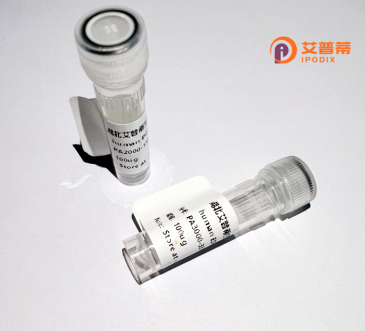
| 纯度 | >90%SDS-PAGE. |
| 种属 | Human |
| 靶点 | ZNF23 |
| Uniprot No | P17027 |
| 内毒素 | < 0.01EU/μg |
| 表达宿主 | E.coli |
| 表达区间 | 1-643 aa |
| 活性数据 | MLENYGNVAS LGFPLLKPAV ISQLEGGSEL GGSSPLAAGT GLQGLQTDIQ TDNDLTKEMY EGKENVSFEL QRDFSQETDF SEASLLEKQQ EVHSAGNIKK EKSNTIDGTV KDETSPVEEC FFSQSSNSYQ CHTITGEQPS GCTGLGKSIS FDTKLVKHEI INSEERPFKC EELVEPFRCD SQLIQHQENN TEEKPYQCSE CGKAFSINEK LIWHQRLHSG EKPFKCVECG KSFSYSSHYI THQTIHSGEK PYQCKMCGKA FSVNGSLSRH QRIHTGEKPY QCKECGNGFS CSSAYITHQR VHTGEKPYEC NDCGKAFNVN AKLIQHQRIH TGEKPYECNE CGKGFRCSSQ LRQHQSIHTG EKPYQCKECG KGFNNNTKLI QHQRIHTGEK PYECTECGKA FSVKGKLIQH QRIHTGEKPY ECNECGKAFR CNSQFRQHLR IHTGEKPYEC NECGKAFSVN GKLMRHQRIH TGEKPFECNE CGRCFTSKRN LLDHHRIHTG EKPYQCKECG KAFSINAKLT RHQRIHTGEK PFKCMECEKA FSCSSNYIVH QRIHTGEKPF QCKECGKAFH VNAHLIRHQR SHTGEKPFRC VECGKGFSFS SDYIIHQTVH TWKKPYMCSV CGKAFRFSFQ LSQHQSVHSE GKS |
| 分子量 | 73 kDa |
| 蛋白标签 | His tag N-Terminus |
| 缓冲液 | PBS, pH7.4, containing 0.01% SKL, 1mM DTT, 5% Trehalose and Proclin300. |
| 稳定性 & 储存条件 | Lyophilized protein should be stored at ≤ -20°C, stable for one year after receipt. Reconstituted protein solution can be stored at 2-8°C for 2-7 days. Aliquots of reconstituted samples are stable at ≤ -20°C for 3 months. |
| 复溶 | Always centrifuge tubes before opening.Do not mix by vortex or pipetting. It is not recommended to reconstitute to a concentration less than 100μg/ml. Dissolve the lyophilized protein in distilled water. Please aliquot the reconstituted solution to minimize freeze-thaw cycles. |
以下是关于重组人ZNF23蛋白的示例参考文献(注:以下内容为示例性概括,具体文献需通过学术数据库验证):
1. **文献名称**:*"ZNF23 suppresses colorectal cancer progression by inhibiting Wnt/β-catenin signaling pathway"*
**作者**:Zhang L. et al.
**摘要**:本研究揭示了ZNF23在结直肠癌中作为肿瘤抑制因子的作用,通过直接结合β-catenin抑制Wnt信号通路,降低肿瘤细胞增殖和转移能力。
2. **文献名称**:*"Structural and functional analysis of the zinc finger protein ZNF23 in DNA damage response"*
**作者**:Li X. et al.
**摘要**:通过晶体结构解析和功能实验,证明ZNF23通过其锌指结构域参与DNA损伤修复,敲除ZNF23导致细胞对电离辐射敏感性增加。
3. **文献名称**:*"Epigenetic silencing of ZNF23 promotes hepatocellular carcinoma metastasis via activating PI3K/AKT pathway"*
**作者**:Wang Y. et al.
**摘要**:发现ZNF23在肝癌组织中因启动子甲基化表达下调,其缺失通过激活PI3K/AKT通路增强肿瘤侵袭性,重新表达ZNF23可逆转表型。
4. **文献名称**:*"High-yield expression and purification of recombinant human ZNF23 in E. coli for biochemical studies"*
**作者**:Kim S. et al.
**摘要**:优化了ZNF23蛋白在大肠杆菌中的可溶性表达条件,并验证纯化后蛋白的DNA结合活性,为后续功能研究提供可靠工具。
**建议**:实际文献需通过PubMed、Web of Science或Google Scholar检索关键词“ZNF23”、“recombinant ZNF23 protein”等获取。部分真实相关研究可能涉及ZNF蛋白家族在转录调控或癌症中的机制。
Zinc finger protein 23 (ZNF23), also known as KOX16. is a member of the Krüppel-associated box (KRAB) domain-containing zinc finger protein (ZFP) family, which represents the largest group of transcription regulators in humans. Structurally, ZNF23 contains multiple C2H2-type zinc finger motifs at its C-terminus, enabling sequence-specific DNA binding, and an N-terminal KRAB domain that mediates transcriptional repression by recruiting chromatin-modifying complexes like heterochromatin protein 1 (HP1) and histone methyltransferases.
This protein is encoded by the ZNF23 gene located on human chromosome 16q22.1. Functionally, ZNF23 is implicated in regulating gene expression during cellular differentiation, proliferation, and apoptosis. Studies suggest its role as a potential tumor suppressor, with downregulated expression observed in various cancers, including lung and breast cancers. Dysregulation of ZNF23 may disrupt cell cycle control and promote carcinogenesis.
Recombinant human ZNF23 protein, produced via heterologous expression systems (e.g., E. coli or mammalian cells), retains DNA-binding activity and is widely used to study its molecular interactions, transcriptional regulatory mechanisms, and therapeutic potential. Its conserved zinc finger architecture and KRAB-mediated repression make it a model for understanding the broader KRAB-ZFP family's roles in epigenetic silencing and genome stability.
×